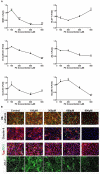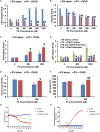Blood-Brain Barrier Cellular Responses Toward Organophosphates: Natural Compensatory Processes and Exogenous Interventions to Rescue Barrier Properties
- PMID: 30459557
- PMCID: PMC6232705
- DOI: 10.3389/fncel.2018.00359
Blood-Brain Barrier Cellular Responses Toward Organophosphates: Natural Compensatory Processes and Exogenous Interventions to Rescue Barrier Properties
Abstract
Organophosphorus compounds (OPs) are highly toxic chemicals widely used as pesticides (e.g., paraoxon (PX)- the active metabolite of the insecticide parathion) and as chemical warfare nerve agents. Blood-brain barrier (BBB) leakage has been shown in rodents exposed to PX, which is an organophosphate oxon. In this study, we investigated the cellular mechanisms involved in BBB reaction after acute exposure to PX in an established in vitro BBB system made of stem-cell derived, human brain-like endothelial cells (BLECs) together with brain pericytes that closely mimic the in vivo BBB. Our results show that PX directly affects the BBB in vitro both at toxic and non-toxic concentrations by attenuating tight junctional (TJ) protein expression and that only above a certain threshold the paracellular barrier integrity is compromised. Below this threshold, BLECs exhibit a morphological coping mechanism in which they enlarge their cell area thus preventing the formation of meaningful intercellular gaps and maintaining barrier integrity. Importantly, we demonstrate that reversal of the apoptotic cell death induced by PX, by a pan-caspase-inhibitor ZVAD-FMK (ZVAD) can reduce PX-induced cell death and elevate cell area but do not prevent the induced BBB permeability, implying that TJ complex functionality is hindered. This is corroborated by formation of ROS at all toxic concentrations of PX and which are even higher with ZVAD. We suggest that while lower levels of ROS can induce compensating mechanisms, higher PX-induced oxidative stress levels interfere with barrier integrity.
Keywords: blood-brain barrier; organophosphates; paraoxon; permeability; tight junction.
Figures






Similar articles
-
Caspase-1 has a critical role in blood-brain barrier injury and its inhibition contributes to multifaceted repair.J Neuroinflammation. 2020 Sep 9;17(1):267. doi: 10.1186/s12974-020-01927-w. J Neuroinflammation. 2020. PMID: 32907600 Free PMC article.
-
Vascular Cell Senescence Contributes to Blood-Brain Barrier Breakdown.Stroke. 2016 Apr;47(4):1068-77. doi: 10.1161/STROKEAHA.115.010835. Epub 2016 Feb 16. Stroke. 2016. PMID: 26883501 Free PMC article.
-
Omi/HtrA2 Protease Associated Cell Apoptosis Participates in Blood-Brain Barrier Dysfunction.Front Mol Neurosci. 2019 Feb 22;12:48. doi: 10.3389/fnmol.2019.00048. eCollection 2019. Front Mol Neurosci. 2019. PMID: 30853894 Free PMC article.
-
Junctional proteins of the blood-brain barrier: New insights into function and dysfunction.Tissue Barriers. 2016 Feb 26;4(1):e1154641. doi: 10.1080/21688370.2016.1154641. eCollection 2016 Jan-Mar. Tissue Barriers. 2016. PMID: 27141427 Free PMC article. Review.
-
Blood-brain barrier tight junction permeability and ischemic stroke.Neurobiol Dis. 2008 Nov;32(2):200-19. doi: 10.1016/j.nbd.2008.08.005. Epub 2008 Aug 27. Neurobiol Dis. 2008. PMID: 18790057 Review.
Cited by
-
Caspase-1: an important player and possible target for repair of the blood-brain barrier underlying neurodegeneration.Neural Regen Res. 2021 Dec;16(12):2390-2392. doi: 10.4103/1673-5374.313031. Neural Regen Res. 2021. PMID: 33907012 Free PMC article. Review. No abstract available.
-
Caspase-1 has a critical role in blood-brain barrier injury and its inhibition contributes to multifaceted repair.J Neuroinflammation. 2020 Sep 9;17(1):267. doi: 10.1186/s12974-020-01927-w. J Neuroinflammation. 2020. PMID: 32907600 Free PMC article.
-
New Lipidyl-Cyclodextrins Obtained by Ring Opening of Methyl Oleate Epoxide Using Ball Milling.Biomolecules. 2020 Feb 20;10(2):339. doi: 10.3390/biom10020339. Biomolecules. 2020. PMID: 32093153 Free PMC article.
-
The Diverse Roles of Reactive Astrocytes in the Pathogenesis of Amyotrophic Lateral Sclerosis.Brain Sci. 2024 Feb 4;14(2):158. doi: 10.3390/brainsci14020158. Brain Sci. 2024. PMID: 38391732 Free PMC article. Review.
-
Raising the Alarm: Environmental Factors in the Onset and Maintenance of Chronic (Low-Grade) Inflammation in the Gastrointestinal Tract.Dig Dis Sci. 2022 Sep;67(9):4355-4368. doi: 10.1007/s10620-021-07327-1. Epub 2022 Jan 4. Dig Dis Sci. 2022. PMID: 34981314 Review.
References
-
- Alluri H., Stagg H. W., Wilson R. L., Clayton R. P., Sawant D. A., Koneru M., et al. (2014). Reactive oxygen species-caspase-3 relationship in mediating blood-brain barrier endothelial cell hyperpermeability following oxygen-glucose deprivation and reoxygenation. Microcirculation 21 187–195. 10.1111/micc.12110 - DOI - PubMed
LinkOut - more resources
Full Text Sources

